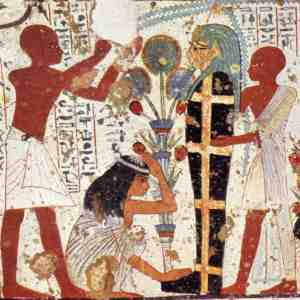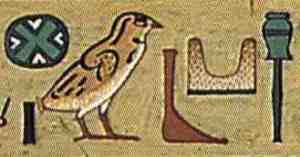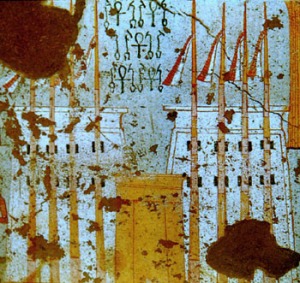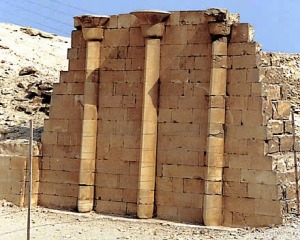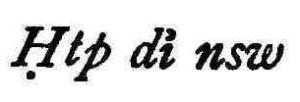OK. So far so good. This is where it gets confusing. There are umpteen gods called Horus in the ancient Egyptian pantheon. The most famous one is the son of Isis and Osiris, but that’s not who we’re talking about here. Horus the Elder is his uncle, the fifth, anomalous offspring of Nut, although under the influence of other Horuses he has been known to be considered the son of Isis. Well, you know what it’s like when two close family members have the same name. They answer each other’s calls, open each other’s mail, get arrested for each other’s offences… To make things worse, both the elder and younger Horuses married a goddess called Hathor. Imagine what it must have been like in the company mailroom.
Horus the Elder’s main cult centre was at Letopolis, modern Ausim, a dozen kilometres or so north-west of Cairo. There’s not much left of his temple there now, but there is rather more left of the temple of Kom Ombo in Upper Egypt, where Horus shared his accommodation with a flatmate, the crocodile god Sobek. Here’s a portrait of Horus from his Nile Valley residence:
Regular readers of this blog will know that the divine company history had always been a turbulent one, even before the arrival of the Children of Nut. You’ll also remember how ruthlessly the real stories of many attempted – and successful – boardroom coups by each succeeding generation were suppressed by the company founders. But legends will persist, even in open plan offices.
The legend about Horus the Elder is that he owed his seniority to one such attempted coup. Atum got wind that a faction in the family firm – the names of the guilty have been successfully withheld from the public – was plotting against him. Atum was getting on in years by now and didn’t feel able to confront them directly, especially as they were his own family and would presumably get to choose his retirement home. He needed to get a handle on the size of the forces ranged against him, so he sent out a company spy to hang around the water cooler, listen in to the gossip and report back. We’ve all met them.
The spy discovered that eight senior executives and two hundred and fifty-seven of the workforce, backed up by a huge army, were doing nothing but slandering Atum at every water cooler, tea point, restroom and smoking break in the company. Just as he uncovered this information, the conspirators realised he was a spy and took immediate action: they stuck out their tongues at him. This was apparently much more frightening then than it is now – maybe because it was a reminder that the Egyptians used to cut out the tongues of the slain on the battlefield. Anyway, the spy acted in the time-honoured tradition of snitches everywhere and ran straight back to Atum.
Atum immediately called in company secretary Thoth for high-level counter-coup discussions. Thoth advised him to choose a high-profile individual to champion Atum’s policies in the workplace. Atum chose Horus the Elder, put him in uniform, armed him to the hilt and let him rip. The result was a massacre and a flight of the vanquished, some of whom turned into fish and birds to effect their getaway. Well, even if they’d had company cars then, they’d have had to give them back. But it was no use: whatever they turned into, Horus copied, hunting them down and exterminating them wherever they were hidden. It was worse than a government leak inquiry. Eventually, though, company order was restored and Horus found himself promoted above his peers for services rendered, becoming “leader of the troops”. Here he is, not in a portrait this time but in a rather fine bronze, as a Roman soldier:
You have to admire Horus the Elder all the more once you know t hat the company champion had battled disability to achieve his excellent performance rating and an enviable promotion. Horus the Elder’s two eyes represented the sun and the moon. On pitch dark nights when these two heavenly bodies were invisible, the god used to go blind. On these occasions he was known in the company as Mekhenty-en-irty, “he who has no eyes”. In his blind form, he swapped his falcon’s head for the head of a shrew, an animal thought to fear broad daylight. When he recovered his eyesight, he was known as Khenty-en-irty, “he who has eyes”. At one of Horus’ cult centres, Kom Ombo, the priests commissioned a carving of surgical and medical instruments for the temple wall, in which the eye doctor’s equipment has a prominent place.
Well, it never ends there, does it? If you promote one of five siblings, the others are bound to feel a certain grievance. And you have to remember, company grievance procedures were much less sophisticated then. At any rate, these events were soon followed by a rebellion of the Children of Nut against Chairman Atum. Horus the Elder had to take up his sword again.
The rebellion came to a head on board the solar bark. It was a pitch dark night, Horus the Elder couldn’t see a thing, he was on a mission and he was armed with a sword. You can imagine what was about to happen. Horus didn’t let the mere fact of his blindness hold him back; he set about himself with a vengeance, lopping off heads left right and centre. When the sun came up in the morning, he found that he had decapitated not only half the workforce but a lot of the gods as well. Talk about swingeing cuts – Horus the Elder was the George Osborne of his day. The company ship came to a halt – as the crew had been beheaded, that was probably inevitable – one of the four pillars holding up the sky fell into the primeval ocean and the universe stood tottering on the brink of collapse. (That’s what happens when you implement radical retrenchments too quickly, George – let that be a warning to you.) Fortunately, the Chairman was able to restore the gods’ heads to their shoulders and, after a kindly but firm word with the junior executives about their future career prospects, Atum was able to effect repairs and the company ship sailed on.
So, if you’re poised pen in hand over yet another leaving card, about to write your offering formula and wondering which god to select for yet another colleague whose job has been axed, Horus the Elder might be the one. He’d also be good for one of those slash-and-burn types, or salami-slicers of services. We’ll have a look at exactly how you write him in there next time.


















